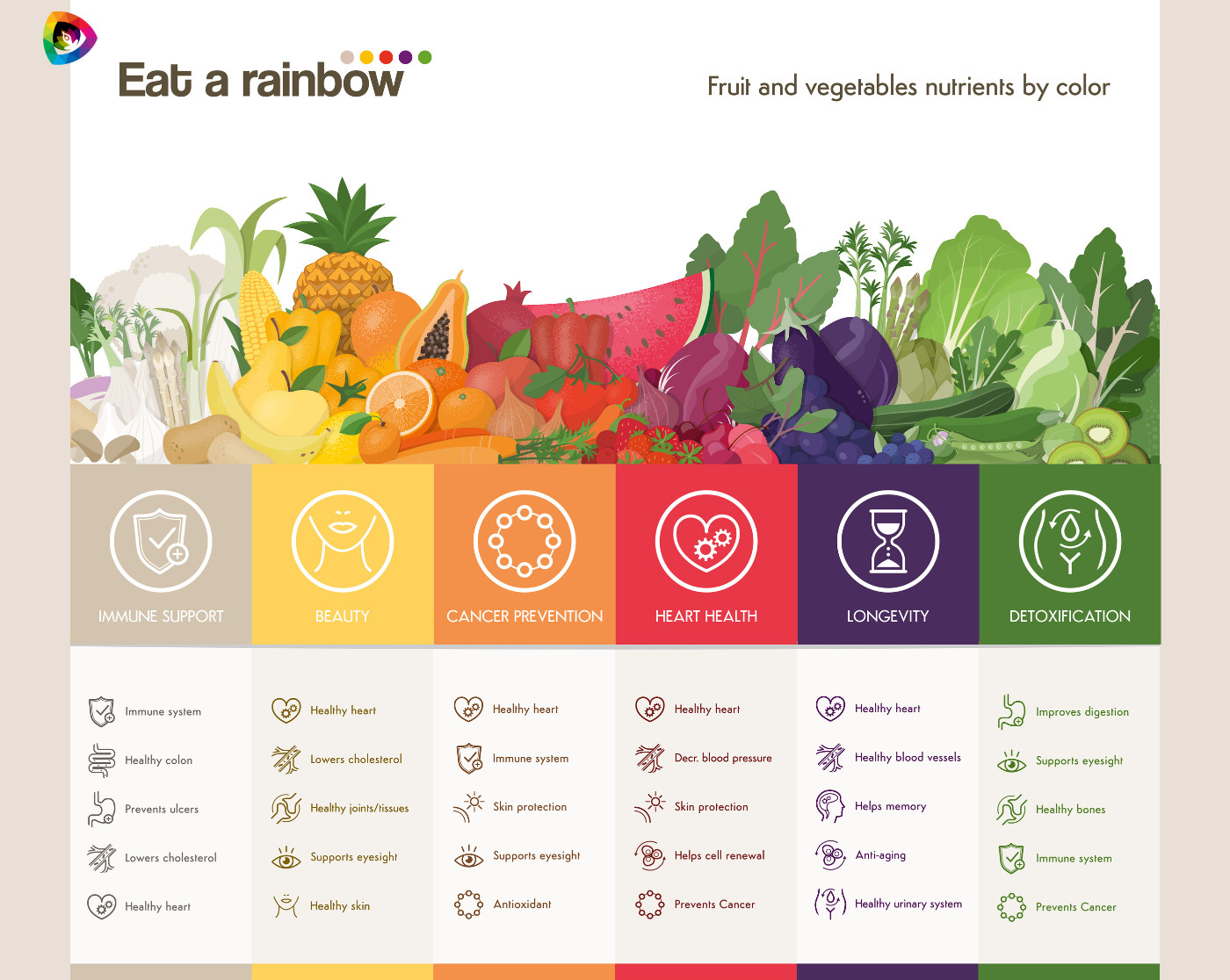The Science of Eating a Rainbow: Unlocking the Nutritional Power of Colors

The phrase “eat a rainbow” isn’t just about making your plate Instagram-worthy. It’s a science-backed strategy to nourish your body with a variety of vitamins, minerals, antioxidants, and phytonutrients. Every color in fruits and vegetables offers unique health benefits, targeting specific areas of your wellbeing. Let’s delve deeper into the science behind each color and why a diverse diet is the foundation of optimal health.
1. Immune Support: The Power of Whites and Neutrals
Foods like garlic, onions, cauliflower, and mushrooms are often overlooked but pack a powerful punch. These neutral-colored foods contain compounds such as allicin and polyphenols that are known to:
- Boost Immunity: Allicin in garlic has antimicrobial properties, helping the body fight infections. Research published in the Journal of Immunology indicates that garlic can reduce the duration of colds by 70%.
- Support Colon Health: Cauliflower and mushrooms are rich in fiber and prebiotics, which promote a healthy gut microbiome—an essential aspect of immune health.
- Lower Cholesterol: Studies show that garlic reduces LDL cholesterol levels by up to 10% when consumed regularly.
Example:
Start your day with a mushroom and cauliflower stir-fry seasoned with garlic. This simple dish boosts immunity and supports digestion.
2. Radiant Beauty: The Magic of Yellows and Oranges
Carrots, sweet potatoes, and citrus fruits are more than just vibrant additions to your plate—they are beauty enhancers from within. These foods are rich in beta-carotene, Vitamin C, and flavonoids, which:
- Improve Skin Health: Beta-carotene in carrots and sweet potatoes converts into Vitamin A, essential for skin repair and reducing signs of aging.
- Support Vision: Beta-carotene is also a precursor to rhodopsin, a pigment in your eyes that helps you see in low light.
- Enhance Joint and Tissue Health: Vitamin C supports collagen production, crucial for maintaining joint flexibility and youthful skin.
Example:
Blend a smoothie with oranges, mango, and turmeric to create a beauty elixir loaded with antioxidants and Vitamin C.
3. Cancer Prevention: Reds That Heal
Red fruits and vegetables like tomatoes, strawberries, and watermelons are nature’s shields against chronic diseases. Their high lycopene and anthocyanin content have been linked to:
- Cancer Prevention: Lycopene, found in tomatoes, reduces the risk of prostate and breast cancer. According to a study in The American Journal of Clinical Nutrition, high lycopene intake lowers the risk of certain cancers by 23%.
- Skin Protection: Anthocyanins in berries help reduce UV-induced skin damage.
- Cell Renewal: These compounds enhance cellular repair, reducing oxidative stress and slowing aging.
Example:
Enjoy a fresh tomato and watermelon salad for a refreshing dose of lycopene and hydration.
4. Heart Health: The Power of Purples
Purple and blue foods such as blueberries, eggplants, and plums are heart-healthy champions. Their deep hues come from anthocyanins and resveratrol, which:
- Lower Blood Pressure: Studies from the American Heart Association show that anthocyanins improve arterial flexibility and reduce hypertension.
- Strengthen Blood Vessels: Resveratrol in grapes enhances endothelial function, reducing the risk of heart disease.
- Boost Cognitive Health: Purple foods are also known to improve memory by reducing oxidative damage in the brain.
Example:
Snack on a handful of blueberries or add them to your oatmeal to support both heart and brain health.
5. Longevity and Detox: The Green Superfoods
Spinach, kale, broccoli, and kiwi are the epitome of detoxification and longevity. These greens contain chlorophyll, lutein, and isothiocyanates, which:
- Detoxify the Body: Chlorophyll binds to toxins in the digestive tract, aiding their elimination.
- Improve Digestion: Fiber-rich greens promote gut motility and nutrient absorption.
- Boost Bone Health: Kale and broccoli are rich in Vitamin K, essential for bone density.
- Enhance Immunity: Antioxidants like lutein protect cells from free radical damage, contributing to longevity.
Example:
Prepare a vibrant green smoothie with spinach, kiwi, and cucumber to detoxify and energize your day.
The Science of Synergy
Eating a rainbow is not just about individual nutrients but how they work together. For example, pairing tomatoes (rich in lycopene) with healthy fats like olive oil enhances nutrient absorption. Similarly, Vitamin C from citrus fruits boosts the iron absorption from leafy greens.

Final Thoughts: Progress Over Perfection
You don’t need to overhaul your entire diet overnight. Start by incorporating one additional color into your meals each day. Over time, this small habit will compound into a vibrant, nutrient-rich diet that supports immune health, beauty, longevity, and more.







Responses